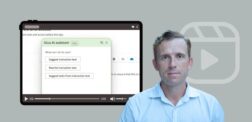
When employees write their own job aids

At Medicom Innovation Partner, the QA department has a focus on colleague involvement and helps their colleagues to write parts of the job aids, or work instructions, for themselves. Read how in this interview with the QA manager.
Medicom Innovation Partner A/S produces medical equipment. Here is the first part of the interview with QA manager, Søren Lyngsø-Petersen.
Medicom Innovation Partner in short…
The company primarily develops injection equipment, and for the past 25 years has dominated the Danish market. 50 of their 85 employees are directly involved in development. The Quality Assurance department located in Denmark has 13 employees, and production only 14 employees. Medicom Innovation Partner is certified according to ISO 13485:2012, ISO 13485:2003 CMDCAS (Canadian Medical Devices Regulations), and ISO 14001.
The role of the QA department is more than creating job aids
Søren Lyngsø-Petersen explains that the primary role of the QA department is to ensure that all certification requirements are observed. Documentation is especially important in the development of Medical Devices, and the requirements are extensive. Therefore, they have a comprehensive quality assurance system, where, among other things, they use Lotus Notes. The Quality Assurance system makes it possible to approve documents electronically and lets the various employee groups know when changes have been made and the system has been updated.
Søren Lyngsø-Petersen describes the unique attitude regarding quality throughout the company:
”…So in that way, it’s a little different, and there is a good managerial attitude about quality. Among the employees the attitude is fantastic.”
The QA department as a service department
To help with job aids, Medicom Innovation Partner developed a series of templates for use when documents are being created. This ensures the inclusion of all relevant details and information, so all regulatory requirements are fulfilled.
The Medical Device industry requires a lot of documentation – which often comes as a surprise and a challenge for some employees. Søren Lyngsø-Petersen explains:
”In my experience, for many, writing and starting a document from scratch is difficult. There are some who are just stumped, and others have general difficulty expressing themselves. Therefore, we have made templates for everything you could possibly make a template for.”
If a colleague does not have the competency to complete a document, it is the job of the QA department to help with this. Søren Lyngsø-Petersen points out, however, that it is important for the individual colleague in these situations to provide their own input since they were the ones to think the thoughts and use the methods. He, himself, compares the QA department to a service department:
”We need to provide services to the development people and production in the best possible way. We, in the QA department, have an understanding of the requirements we’re up against, and we’re the ones who are used to writing, so that’s what we help do as well as we can along the way.”
Besides templates that make the documentation easier to fill out, their purpose is also to standardise the documentation process across various projects and project managers.
The art of creating job aids
In spite of templates and a fantastic attitude about quality, they also face challenges in job aids – especially in regard to development work. Therefore, they have a particular focus on involvement in this group as much as possible in the process of creating job aids. Søren Lyngsø-Petersen says that here he is sure to talk to them about ensuring the quality of their work and he involves them in writing the procedures they need to follow. He says:
”That way they somehow develop a kind of commitment to the procedure. Here, my job is to ensure that they are in compliance with regulatory requirements and the standard requirements.”
Aside from helping the employees to see a purpose with the documentation, Søren explains that focus on employee involvement also creates a common language and commitment:
“This is my trick – and has been my whole life – involving people and explaining to them why they need to do it.”
The ideal management system is easy to use
I asked Søren Lyngsø-Petersen, how he views the ideal management system of the future. At this, he answered that first and foremost it needs to be electronic and have the support of management:
”If you are in a company, where management thinks that quality assurance is nonsense, but they have it because the customers want it and the authorities require it, that’s never optimal. This is why the support of management is incredibly important.”
In addition, he also answered that an important key for the ideal and well-functioning management system is that everyone can understand it and that it uses language that is easy to read.
About the ideal and well-functioning management system, Søren Lyngsø-Petersen concludes:
”If it is difficult, people won’t use it. This is why you have to write in a language people can understand. It doesn’t have to be so academic.”
Convinced that work guides or instructions should be curated by their operators? Check out our guide to work instructions, it will help you plan, implement and iterate on your work instructions efficiently.
This was the first part of our case with Medicom Innovation Partner A/S. Check out part two, where we asked Søren Lyngsø-Petersen how they handle aberrations and change processes in practical terms.
Frequently Asked Questions
MediCom implemented specific strategies primarily focused on using Gluu’s platform and digitizing their workflows to improve efficiency. Instead of sticking to manual, paper-based processes, MediCom targeted digital automation to streamline operations and enhance efficiency. The adaptability and flexibility of Gluu’s platform brought smoothness to this transition, playing a crucial role in managing the changes.
The complete transformation of MediCom’s change processes lasted about two years. Beginning in 2017, the organization embarked on a journey to overhaul its practices, with the majority of changes implemented within first year. The next year was then spent refining these changes and ensuring that they were fully embedded into daily procedures.
As for the success of Gluu’s implementation, there are indeed several metrics that demonstrate its impact. For example, there was a significant reduction in manual administrative work, pointing to an efficiency increase in non-clinical operations. Additionally, according to employees, there was a noticeable improvement in cross-departmental cooperation and communication, which led to smoother, more effective workflows. Although exact figures have not been disclosed, these positive feedback clearly indicates the successful implementation of Gluu’s platform in MediCom’s workflow processes.



